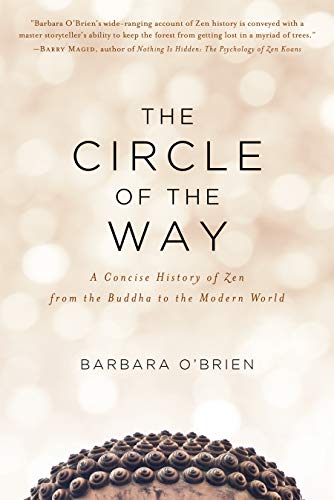 Barbara O’Brien’s The Circle of the Way: A Concise History of Zen from the Buddha to the Modern World (Shambhala, 2020) is, I believe, the first English-language history of Zen to be published since Heinrich Dumoulin’s two-volume Zen Buddhism: A History was translated from the German two decades ago. A lot has happened since then, including a continuing explosion of interest in Zen in the West, new scholarly research into Zen’s origins, revelations about Zen’s role in collaborating with Japanese militarism, a series of sex abuse scandals involving teachers in American Zen centers, and sociopolitical critiques of Buddhist institutions from millennials, feminists, the LGBTQ community, and people of color. Dumoulin’s densely written history, for all its virtues, was never an easy read for the non-scholar, and was also a Zen history as seen from a Jesuit perspective. The Zen world has needed a new history that includes newer developments, and one that is written for the benefit of practitioners rather than academics.
Barbara O’Brien’s The Circle of the Way: A Concise History of Zen from the Buddha to the Modern World (Shambhala, 2020) is, I believe, the first English-language history of Zen to be published since Heinrich Dumoulin’s two-volume Zen Buddhism: A History was translated from the German two decades ago. A lot has happened since then, including a continuing explosion of interest in Zen in the West, new scholarly research into Zen’s origins, revelations about Zen’s role in collaborating with Japanese militarism, a series of sex abuse scandals involving teachers in American Zen centers, and sociopolitical critiques of Buddhist institutions from millennials, feminists, the LGBTQ community, and people of color. Dumoulin’s densely written history, for all its virtues, was never an easy read for the non-scholar, and was also a Zen history as seen from a Jesuit perspective. The Zen world has needed a new history that includes newer developments, and one that is written for the benefit of practitioners rather than academics.
O’Brien’s new volume has a lot to offer that the older volume did and could not. First, it is written in a personal conversational style that Zen practitioners will find a pleasure to read. Second, it incorporates much of the newer critical Zen scholarship. Third, it emphasizes aspects of Zen history previously hidden from view, especially the role of women in Zen. Fourth, it is written by an author who understands and appreciates the value of Zen practice from personal experience.
At just under 300 pages, the book does not aim at being truly comprehensive. O’Brien takes us on a tour of the highlights of the evolution of Zen—the major figures and major doctrinal disputes—as well as the historical context (invasions, civil wars, dynastic changes) in which these events occurred in Asia and the West. We get to meet host of colorful characters who played major roles in Zen history—including Chinese Tang Dynasty teachers like Zhaozhou, Linji, and Dongshan; Chinese Song Dynasty teachers like Hongzhi and Dahui; Japanese innovators like Dogen and Hakuin; and twentieth-century Western pioneers like Alan Watts, Ruth Fuller, and Robert Aitken. Her book covers the history of Asian Zen not only in India, China, and Japan, but also Korea and Viet Nam.
O’Brien’s range of knowledge is impressive, and her grasp of the overall evolution of Zen secure. Her emphasis is in providing a coherent history rather than getting into the weeds of negotiating fine details of doctrine. Thus she summarizes Yogacara in just under three pages, while Huayan doesn’t even merit its own subheading, although it’s alluded to here and there. She has less to say about the major changes in Zen during the Meiji Restoration than I would have liked. But that’s all right; there is only so much one book can do.
I am impressed by how much O’Brien gets right; She has done her research, and it shows. Beyond her erudition, I was struck by O’Brien’s common sense and ready wit as she threaded her way through a number of knotty scholastic disputes. She walks a fine line between accepting the value of contemporary academic critiques while still finding value in the old stories being critiqued. For example, when we read the alleged Tang Dynasty Zen teacher-student dialogues as recounted in the Song Dynasty literature, how much does it matter whether these are historically accurate conversations or accounts of actual events? Sophisticated Judeo-Christians understand this when it comes to the Judeo-Christian tradition. It makes little difference to them whether the Biblical character of Job actually existed. The story of Job retains its meaning for moderns whether it is an historically accurate recounting of real events or not. The same is true of the Zen tradition. In fact, in some ways it might even be comforting to think that Huike didn’t really cut his arm off, or that Nansen didn’t really kill that cat, or that many of the nose tweaking and fly whisk hitting antics described in the Lamp literature may never have actually occurred. The most important question is, do these stories still resonate with us today, do they still have wisdom to disclose, and do they still foster insight? O’Brien argues that they do, and we should be careful not to throw out the baby with the bath water.
O’Brien understands the things Zen got and still gets wrong. She doesn’t whitewash Zen’s collaboration with the Japanese military during World War II. She understands the problems of historical and enduring bias against women and the disheartening abuse of women practitioners by some historically important Zen figures. But she also understands and appreciates the value of what she has gained from her Zen practice and what Zen has to offer the West. It’s that kind of clear-eyed non-defensive wisdom that Zen tries to instill in its practitioners, and it’s that kind of wisdom that is on display from cover to cover in this book.
